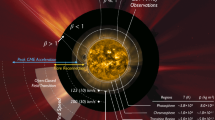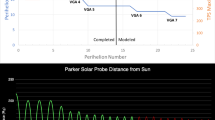Abstract
The results of studying the fluxes of solar protons with energies greater than 5 MeV in near-Earth space on March 13–23, 2023, are presented. The features of the period under study are no visible solar flare with which the beginning of the event could be associated and an untypical time profile of proton fluxes, as well as a long duration of the existence of solar proton fluxes in near-Earth space. An attempt was made to explain the sources of the observed different variations in particle fluxes and to understand what happened on the Sun and in the near-Earth space. The source of solar protons on March 13, 2023, was an explosive process on the back side of the Sun from the Earth, registered as a coronal mass ejection of very high power. The reason for the long and complex time profile of solar protons was the contribution of particle acceleration processes on the Sun and in the interplanetary medium, as well as the modulation of particle fluxes by the structures of the interplanetary magnetic field. A possible scenario has been proposed to explain the existence of increased fluxes of solar particles on March 15–23, 2023: the formation of a heliospheric structure, this being a closed trap region formed by two interplanetary coronal mass ejections and regions of interaction of high-speed and slow solar wind streams. The study uses experimental data obtained from the Solar Orbiter spacecraft and from spacecraft located near the L1 point of the Earth–Sun system (ACE and DSCOVR) and in geostationary orbit (GOES-16).





Similar content being viewed by others
REFERENCES
Meyer, P., Parker, E.N., and Simson, J.A., Solar cosmic rays of February, 1956 and their propagation through interplanetary space, Phys. Rev., 1956, vol. 104, no. 3, pp. 768–783. https://doi.org/10.1103/PhysRev.104.768
Reames, D.V., Solar energetic particles: a paradigm shift, Rev. Geophys., Suppl., 1995, pp. 585–589.
Bazilevskaya, G.A., Once again about origin of the solar cosmic rays, J. Phys.: Conf. Ser., 2017, vol. 798, p. 012034. https://doi.org/10.1088/1742-6596/798/1/012034
Klein, K.-L. and Dalla, S., Acceleration and propagation of solar energetic particles, Space Sci. Rev., 2017, vol. 212, pp. 1107–1136. https://doi.org/10.1007/s11214-017-0382-4
Struminsky, A.B., Grigorieva, I.Yu., Logachev, Yu.I., and Sadovski, A.M., Two phases of solar flares and a stochastic mechanism for acceleration of electrons and protons, Astrophysics, 2020, vol. 63, pp. 388–398. https://doi.org/10.1007/s10511-020-09643-2
Reames, D.V., The two sources of solar energetic particles, Space Sci. Rev., 2013, vol. 175, pp. 53–92. https://doi.org/10.1007/s11214-013-9958-9
Reid, G.C., A diffusive model for the initial phase of a solar proton event, J. Geophys. Res., 1964, vol. 69, no. 13, pp. 2659–2367. https://doi.org/10.1029/JZ069i013p02659
Axford, W.I., Anisotropic diffusion of solar cosmic rays, Planet. Space Sci., 1965, vol. 13, no. 12, pp. 1301–1309. https://doi.org/10.1016/0032-0633(65)90063-2
Lyubimov, G.P., Reflective model of SCR motion in loop traps, Astron. Tsirkulyar Akad. Nauk SSSR, 1988, no. 1531, pp. 19–20.
Lyubimov, G.P. and Grigorenko, E.E., The reflection model for propagation of solar cosmic rays, Cosmic Res., 2007, vol. 45, no. 1, pp. 9–15.
Reinhard, R. and Wibberenz, G., Propagation of flare protons in the solar atmosphere, Sol. Phys., 1974, vol. 36, no. 2, pp. 473–494. https://doi.org/10.1007/BF00151216
Bazilevskaya, G.A. and Vashenyuk, E.V., Some features of coronal and interplanetary propagation of solar cosmic rays of high energy, Proc. 16th Int. Cosmic Ray Conf., 1979, vol. 5, p. 156.
Leske, R.A., Christian, E.R., Cohen, C.M.S., et al., Observations of the 2019 April 4 solar energetic particle event at the parker solar probe, Astrophys. J. Suppl. Ser., 2020, vol. 246, no. 2. https://doi.org/10.3847/1538-4365/ab5712
Frassati, F., Laurenza, M., Bemporad, A., et al., Acceleration of solar energetic particles through CME-driven shock and streamer interaction, Astrophys. J., 2022, vol. 926, no. 2, pp. 227–246. https://doi.org/10.3847/1538-4357/ac460e
Zhang, M., Cheng, L., Zhang, J., et al., A data-driven, physics-based transport model of solar energetic particles accelerated by coronal mass ejection shocks propagating through the solar coronal and heliospheric magnetic fields, Astrophys. J. Suppl. Ser., 2023, vol. 266, no. 2, pp. 35–54. https://doi.org/10.3847/1538-4365/accb8e
Malandraki, O., Khabarova, O., Bruno, R., et al., Current sheets, magnetic islands, and associated particle acceleration in the solar wind as observed by Ulysses near the ecliptic plane, Astrophys. J., 2019, vol. 881, no. 2. https://doi.org/10.3847/1538-4357/ab289a
Parker, E.N., Interplanetary Dynamic Processes, New York: Wiley Interscience, 1963.
Reames, D.V., How do shock waves define the space-time structure of gradual solar energetic particle events?, Space Sci. Rev., 2023, vol. 219, p. A14. https://doi.org/10.1007/s11214-023-00959-x
Logachev, Yu.I., Bazilevskaya, G.A., Vlasova, N.A., et al., Catalog of solar proton events in the 24th cycle of solar activity (2009–2019), ESDB repository, GC RAS, Moscow, 2022. https://doi.org/10.2205/ESDB-SAD-008
Rodriguez-Pacheco, J., Wimmer-Schweingruber, R.F., Mason, G.M., et al., The Energetic Particle Detector. Energetic particle instrument suite for the Solar Orbiter mission, Astron. Astrophys., 2020, vol. 642, no. A7. https://doi.org/10.1051/0004-6361/201935287
Grigorieva, I.Yu. and Struminsky, A.B., Formation of sources for solar cosmic rays in eruptive flares X6.9 and M5.1 observed August 9, 2011, and May 17, 2012, Astron. Rep., 2022, vol. 66, pp. 481–489. https://doi.org/10.1134/S106377292206004X
Bazilevskaya, G.A., Daibog, E.I., and Logachev, Yu.I., Isolated solar cosmic ray events caused by energetic storm particles (ESPs), Geomagn. Aeron. (Engl. Transl.), 2023, vol. 63, no. 4, pp. 456–463. https://doi.org/10.1134/S0016793223600327
Laitinen, T., Kopp, A., Eenberger, F., et al., Solar energetic particle access to distant longitudes through turbulent field-line meandering, Astron. Astrophys., 2016, vol. 591, no. A18. https://doi.org/10.1051/0004-6361/201527801
Kumar, B., Mathur, S., Garcia, R.A., and Venkatakrishnan, P., On the flare induced high-frequency global waves in the Sun, Astrophys. J. Lett., 2010, vol. 711, pp. L12–L18. https://doi.org/10.1088/2041-8205/711/1/L12
Rodriguez-García, L., Gómez-Herrero, R., Zouganelis, I., et al., The unusual widespread solar energetic particle event on 2013 August 19—solar origin and particle longitudinal distribution, Astron. Astrophys., 2021, vol. 653, p. A137. https://doi.org/10.1051/0004-6361/202039960
Downs, C., Warmuth, A., Long, D.M., et al., Validation of global EUV wave MHD simulations and observational techniques, Astrophys. J., 2021, vol. 911, pp. 118–135. https://doi.org/10.3847/1538-4357/abea78
Bryant, D.A., Cline, T.L., Desai, U.D., and McDonald, F.B., Explorer 12 observations of solar cosmic rays and energetic storm particles after the solar flare of September 28, 1961, J. Geophys. Res., 1962, vol. 67, no. 13, pp. 4983–5000. https://doi.org/10.1029/JZ067i013p04983
Daibog, E.I., Kecskeméty, K., Lazutin, L.L., et al., A 27-day period in the flux of Jovian electrons at the Earth’s orbit, Astron. Rep., 2017, vol. 61, no. 12, pp. 1073–1081. https://doi.org/10.1134/S1063772917120010
Richardson, I.G., Energetic particles and corotating interaction regions in the solar wind, Space Sci. Rev., 2004, vol. 111, pp. 267–376. https://doi.org/10.1023/B:SPAC.0000032689.52830.3e
Reames, D.V., Solar Energetic Particles. A Modern Primer on Understanding Sources, Acceleration and Propagation, Lecture Notes in Physics, Cham: Springer, 2017, vol. 932. https://doi.org/10.1007/978-3-319-50871-9
Richardson, I.G., Solar wind stream interaction regions throughout the heliosphere, Liv. Rev. Sol. Phys., 2018, vol. 15, p. A1. https://doi.org/10.1007/s41116-017-0011-z
Burlaga, L., Berdichevsky, D., Gopalswamy, N., et al., Merged interaction regions at 1 AU, J. Geophys. Res. Space Phys., 2003, vol. 108, no. A12, p. 1425. https://doi.org/10.1029/2003JA010088
Wang, Z., Guo, J., Feng, X., et al., The merging of two stream interaction regions within 1 AU: The possible role of magnetic reconnection, Astrophys. J. Lett., 2018, vol. 869, no. 1, pp. L6–L12. https://doi.org/10.3847/2041-8213/aaf398
ACKNOWLEDGMENTS
The authors are grateful to all the researchers who submit their data on proton fluxes, parameters of the solar wind, and coronal mass ejections via the Internet. Experimental data were obtained at NASA’s Goddard Space Flight Center: for the solar wind and interplanetary magnetic field, in OMNIWeb (http://omniweb.gsfc.nasa.gov/ form/omni_min.html); on solar proton fluxes, in CDAWeb (https://cdaweb.sci.gsfc.nasa.gov). Information on solar flares and coronal mass ejections was obtained from the Coordinated Data Analysis Workshops (https://cdaw.gsfc. nasa.gov) and SOHO LASCO CME CATALOG (http://sidc.oma.be/cactus/catalog.php). The arrival times of CME shock waves were obtained from the website https://kauai.ccmc.gsfc.nasa.gov/CMEscoreboard/.
Funding
The research was carried out within the framework of the scientific program of the National Center for Physics and Mathematics, project “Nuclear and Radiation Physics.”
Author information
Authors and Affiliations
Corresponding author
Ethics declarations
The authors of this work declare that they have no conflicts of interest.
Additional information
Publisher’s Note.
Pleiades Publishing remains neutral with regard to jurisdictional claims in published maps and institutional affiliations.
Rights and permissions
About this article
Cite this article
Vlasova, N.A., Bazilevskaya, G.A., Ginzburg, E.A. et al. Solar Energetic Proton Fluxes in Near-Earth Space on March 13–23, 2023. Cosmic Res 62, 197–209 (2024). https://doi.org/10.1134/S0010952523600282
Received:
Revised:
Accepted:
Published:
Issue Date:
DOI: https://doi.org/10.1134/S0010952523600282




